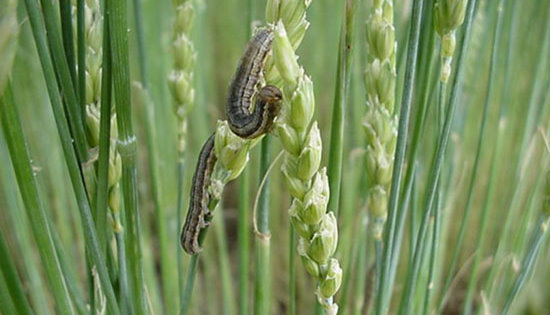
Agricultural News
Watch for Armyworms- the Advice of Tom Royer
Tue, 17 Apr 2012 10:30:58 CDT
 Are Armyworms headed for Oklahoma from wheat fields down in Texas? Dr. Tom A. Royer, Professor and IPM Coordinator for OSU, says it is a possibility. He tells us in a Tuesday morning email that "I received a report from a colleague in Dallas about a flush of armyworms in their wheat, and I noticed several moth flights as I was leaving the canola tours last week. I will be checking wheat fields this week to see if any we are growing a "crop of worms" in our wheat."
Are Armyworms headed for Oklahoma from wheat fields down in Texas? Dr. Tom A. Royer, Professor and IPM Coordinator for OSU, says it is a possibility. He tells us in a Tuesday morning email that "I received a report from a colleague in Dallas about a flush of armyworms in their wheat, and I noticed several moth flights as I was leaving the canola tours last week. I will be checking wheat fields this week to see if any we are growing a "crop of worms" in our wheat."
He has just released an article on scouting for Armyworms- we have his comments below and you can click here for the PDF version which includes several good pictures of what to be looking for.
Dr. Alan Knutson, Extension Entomologist in Dallas reports that wheat producers south of Dallas are battling armyworm infestations. I have noticed armyworm moth flights the past few evenings on my way home from our canola variety tours. These flights could deliver a crop of armyworm caterpillars within the next few weeks, so producers and crop consultants need to check wheat fields for signs of infestation and the worms themselves. Armyworm infestations tend to be focused around waterways, areas of lush growth, or areas with lodged plants. These are the areas to watch closely and determine if the whole field is infested, or the infestation is restricted to a localized area.
Yield loss from armyworm feeding can occur in two ways. First, they cause physiological yield loss when they feed on the flag leaf. They can also cause direct yield loss by "clipping heads" as plants become mature and lose green tissue. Fortunately, head clipping is rare in winter wheat. The head clipping I have noticed over the years occurred on secondary tillers bearing small, green heads that won't contribute much to yield.
Early signs of an infestation include leaves with ragged margins that have been chewed. "Frass" i.e. the excrement from armyworm caterpillars, may be deposited around the base of wheat stems. Scout for armyworms, at 5 or more locations looking for "curled up worms". Armyworm caterpillars tend to feed at night, so a good strategy is to bring a flashlight and check fields after dusk when the armyworms are feeding up the plant stems and grain heads.
The suggested treatment threshold for armyworms is 4-5 unparasitized caterpillars per linear foot of row. Parasitized armyworms can often be recognized by the presence of small white eggs the size of a period on a newspaper that are attached behind its "neck". Generally if wheat is past the soft dough stage, control is not warranted unless obvious head clipping can be seen, and caterpillars are still present and feeding. Worms feeding on the awns after soft dough will not cause enough yield loss to justify the expense of an insecticide application.
Armyworms have a number of natural enemies that help keep populations in check, if given a chance. In particular, parasitic wasps and flies attack them. If you find small white cocoons littered on the ground that are about ¾ the size of a cue tip, the natural enemies have already taken care of the problem.
WebReadyTM Powered by WireReady® NSI
Top Agricultural News
More Headlines...



















